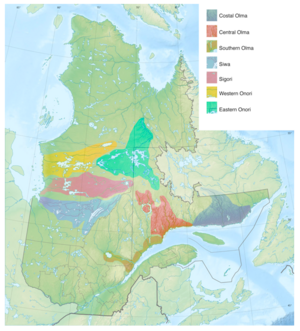Proto-Alopian
| Proto-Alopian | |
|---|---|
| Proto-Siwa | |
| Created by | Étienne L. Poisson |
| Reconstruction of | Alopian |
| Region | Western Canada |
| Era | 2000 BCE |
| Alopian | |
|---|---|
| Created by | Étienne L. Poisson |
| Geographic distribution | Western Canada |
| Linguistic classification | Alopian
|
| Proto-language | Proto-Alopian |
| Subdivisions |
|
 | |
Proto-Alopian is the reconstructed ancestor of the Alopian language family. Little is known about its inventory or possible attestations other than the historical sound changes. It is believed that the Alopian people migrated from Europe around 3000 BCE, in the Holocene epoch.
The two main theories of how this migration took place are either by foot over the frozen oceans of the Last Glacial Period (known as “Early Settlement”) or by boat through the steadily-rising Atlantic Ocean (“Late Settlement”).
After thousands of years of apparent nomadism, the Alopian people settled in present-day Quebec, where the common language began to split in different dialects that would end forming the Alopian languages.
While most words are native (a priori), Proto-Alopian features roots from Uralic and Algonquian languages, as a product of their migration.
Etymology
The word “Alopian” that gives name to the language family comes from the Ancient Greek ᾰ̓λωπός (alōpós) meaning “fox”, a strong cultural item for the Alopian people.
From Proto-Alopian to Siwa
Siwa is by far the most documented Alopian language, part of the Forest Alopian branch, and it is the language of around 30 000–60 000 speakers. The following list gathers most sound changes that Proto-Alopian underwent to become Siwa.